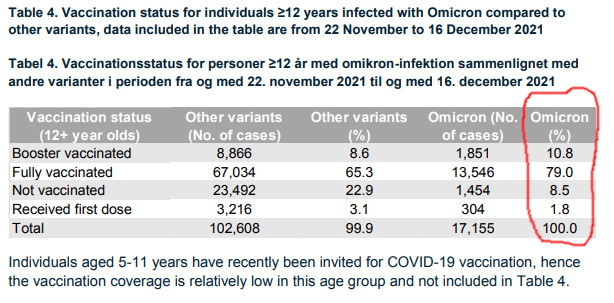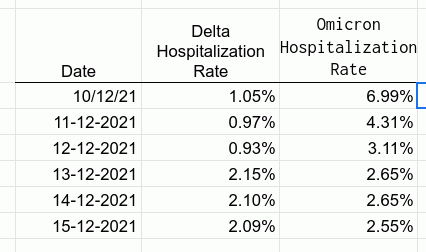Denmark: No-vax is PROTECTIVE; Vax INVITES Omicron
Hospitalization rate same or higher than Delta
Something is rotten in the Danish kingdom.
And what is rotten is the situation with “Covid Vax” and Omicron.
The bad news so far:
According to the latest Denmark reports, being UNvaccinated makes one much LESS likely to get Omicron, than being vaccinated. (!) The “no-vax” is protective, and “vax” invites disease. In fact, the “un-vaccine protection” of being unvaxxed is about 50%! What an amazing treatment no-vax is now.
Hospitalization rate from Omicron is slightly higher than hospitalization rate for Delta, adjusting for time lag between positive test and hospitalization.
Delta is not even starting to slow down in Denmark, judged by absolute number of cases
Greater affinity of Omikron to the vaccinated, going beyond just no protection compared to the unvaxxed, raises concern that vaccination causes ADE (Antibody dependent enhancement)
Denmark’s report suspiciously is missing vaccination status of the hospitalized
Vaccine becoming a joke in Denmark
Look at the latest Omikronvarianten report from Dec 18.
Several things here are obvious:
Only 8.5% of Omicron cases are among the “wholly UN-vaccinated”.
Most Omicron cases occur in 15-60 year olds
Vaccination Rate among 15-60 year olds is approximately 80%
There is about 2% of single-dose not fully vaxxed
So, the “un-vaccination rate”, meaning percentage of completely pure blood un-vaxxed, is about 17%
Therefore, since unvaccinated people comprise 17% of the age sample, but are only 8.5% of cases, they are approximately "50% protected due to not being vaccinated”. Sounds strange, right? We’ll talk about how it works, later.
Omicron hospitalization rate higher than Delta?
I have collected hospitalization data from several recent Omikronvarianten reports. A picture is already emerging. Before discussing it, note that hospitalizations lag cases by about a week or so. People test positive, stay home, most recover, but some decline and end up hospitalized in about a week.
So, looking at the data, note that I compare the number of hospitalizations to the cumulative number of cases, lagging by 6 days. I do that for both Delta as well as Omicron to compare “apples to apples”. Without applying the lag, we would get nonsensical results due to exponential growth of Omicron.
Some things to note here is that in the first few days of Omikronvarianten reports, clearly some data adjustments were made, because Delta hospitalization rate inexplicably jumped on Dec 13, and the first value for Omicron hospitalization also seems out of line. But in the last few days, the picture stabilized and delta hospitalization rate seems to be around 2.1%, whereas Omicron hospitalization rate seems to be around 2.6%.
Please note that properly measuring hospitalization rate requires a cohort study: identify a few of thousands of new Omicron cases, follow these specific people for a few weeks, and count how many end up being hospitalized. Unfortunately, I cannot do this cohort study, and Denmark does not have enough data, but I can try to make estimates using Denmark’s daily reports. My estimates are necessarily extremely imprecise, but they may give us some idea as the apples-to-apples comparison between Delta and Omicron.
Delta is not even stopping
Another weird news here is that Delta cases, so far, are not even declining, they are rising.
I am sure that Delta cases will eventually decline — everything eventually declines — but so far it is a dual rising pandemic, of Delta and Omicron.
ADE - Antibody Dependent Enhancement
The greater affinity of Omicron towards the vaccinated, and the fact that no-vaccination is actually PROTECTIVE, shows that vaccination is not merely useless: vaxx is actively harmful as far as getting a case of Omicron goes. If the vaccine was simply perfectly useless — like a placebo saline solution — this would NOT be the case, and vaccinated, and unvaccinated, would all be infected at the same rate. This is NOT happening here: the vaxxed are infected at a MUCH HIGHER rate, and no-vax gives 50% “protection”.
What is going on? I can think of three explanations.
The unvaccinated include more Covid-recovered who are immune to Covid. This is very uncertain as to the extent of this, as many recovered persons were bamboozled into getting a vaccine also.
The vaccine antibodies are actually aiding and abetting Omicron in penetrating mucosal barrier and overcoming immune defenses. This is called “ADE” and was much discussed on substack, in my previous post as well as many others. Click on the links in the above article.
The vaccine generally destroys immunity, and Omicron evades vaccine antibodies, making Omicron as infectious as without the vaccine, but without the working immune system to oppose it.
Please comment on this and provide your own ideas?
Who is hospitalized?
The biggest question that Denmark can answer, is this: what is the vaccination status of the hospitalized? Are the vaxxed MORE or LESS likely to get hospitalized?
This question seems to be the first to be asked, so I am sure that I am not the first who is asking it. I would suppose that it also came across the minds of Danish researchers. But the answer is missing and I wonder why.
What will happen to the US and UK?
US and UK are in many ways similar to Denmark: similar ethnic composition, similar standard of medicine, and similar vaccination rates. What is different, especially for the US at least, is that our population is a little chubbier and less healthy in general. Our hospitalization rates were always higher than Denmark’s.
UPDATE:

UPDATE: User “jrodder40” just updated us in their comment:
To illustrate how fast things are changing: today's numbers from England show Omicron hospitalizations up to 104 from 85 yesterday, and deaths up to 12 from 7 yesterday.







I am based in Copenhagen, Denmark, and am following the discussion and stats around Covid very closely. I would like to make a few comments on Igor's very stimulating post:
1. First of all, the Danish health authorities do give the figures for vaxxed and non-vaxxed in hospital. Here is the link:
https://experience.arcgis.com/experience/aa41b29149f24e20a4007a0c4e13db1d/page/page_5/
I have been tracking these figures, and they are becoming very interesting. The daily figure for people in hospital has stagnated for the non-vaxxed over the last 9 days, while rising relatively slowly for the vaxxed. Non-vaxxed have gone from 163 in hospital 9 days ago up to 166 today.
Vaxxed have gone, on the other hand, from 284 to 335 or from 300 to 359 if you include the partially vaccinated.
Impt to remember that Delta is still around and through the autumn the hospitalisation rate per 100,000 population has been around 3-4 times higher for the non-vaxxed. This ratio is now shrinking. Denmark has been very, very open since September, schools, bars, work, etc, with everything open, no masks, and pretty much a normal social life. It is apparent from the data that the vaccines did offer some protection, but have been waning in their impact since October, following the chronology of when people were jabbed. So inevitably there has been a rise in Delta cases.
The death rate has risen, but only at low levels.
The Danish authorities do not give direct figures for deaths on a non-vaxxed/vaxxed basis. The figure can be ascertained by looking at the Infection Breakthrough reports, published fortnightly, and then subtracting the vaccinated deaths total given there from the overall Covid death total, to find the non-vaxxed deaths total. I have done this, but the different sources do not match fully. However, it seems that the death rate for the non-vaxxed is slowing dramatically, with only 11% of non-vaxxed in the last period covered by these reports, (26th Nov. up to 7th December. Back in July 100% of Covid deaths, (which were at a very low level of 2-3 per day), were amongst the non-vaxxed. And this share has gradually been falling ever since.
2. The low rate of Omicron infection amongst the non-vaxxed could also be explained by other age and health factors, rather than immune suppression caused by the vaccine per se. The 19% of population who are not vaccinated includes children under 12, many young adults, and a cohort of people who have their own self-management programmes for staying healthy. Whereas the vaccinated, particularly the boostered, include many older, frailer people, and people with some metabolic issues. This may explain the greater susceptibility which is showing up so dramatically in the figures. But obviously something to keep a close eye on, in case immune suppression from the vaccines is involved.
3. I am not sure how Igor is working out his hospitalisation figures. A calculation is given for this in the daily Omicron reports. Here is the most recent:
Tabel 6, Page 8: https://www.ssi.dk/-/media/cdn/files/covid19/omikron/statusrapport/rapport-omikronvarianten-19122021-hp16.pdf?la=da
This gives a hospitalisation rate of 0.6% for Omicron between the 22nd November and the 16th December. That figure may rise a little as there are more and more cases of Omicron, a few of which have yet to be processed from the 15th and 16th December. But it is doubtful if this very low figure becomes anything significant some four days after the closing date for that calculation.
Perhaps even more significant is the apparent short duration of any hospital stays that Omicron infections are leading to. By the 16th December, there had been 114 hospitalisations in total, yet by today, 19th December, there were only 30 Omicron infected people in hospital. This suggests that Omicron hospital treatments last a few days at most, and probably less for many.
Almost none of these points, which emerge from the latest data, are being discussed in the media or by the politicians. There is a desperate rush to get as many vaccinated as possible, particularly children, for whom vaccination has recently been approved. Anecdotedly, Omicron is a cold, and one can hope or presume that this will be reflected in the public discussion soon.
4. Although it is probably a little early to be conclusive, it does seem that Omicron is rapidly displacing Delta. The most recent day we have, where all Omicron cases had been counted was the 14th December, (last Tuesday), when Omicron accounted for 38.4% of all cases, up from 21.9% two days previously. If the Omicron had to continued to grow at the lower end of previous growth rate, (say 5% per day), then Omicron would be up around 65% by today. Infections have fallen markedly the last 2 days, (from over 11,000 to 8,212 today), and this could reflect a decline in Delta. Again not conclusive, but something that should be clarified over the course of the next 3-4 days.
2.
Once again many thanks for taking the time to produce this sort of information. It’s a comfort knowing that my initial scepticism about the jab, which resulted in the end of a 35 yr friendship as this friend tried to persuade me that I must have it as she’d been involved in the initial trials and it was going to save mankind, yadda, yadda. I just didn’t trust that the pharma companies, which are after all businesses wanting to make a profit, would be open and honest about their research. They’d tapped in to the never ending money tree with this jab. They’re a pharmaceutical company who make money from people being ill, they’re hardly likely to want a ‘cure’ as it would cut off their never ending income stream. Oh dear, I do sound sceptical